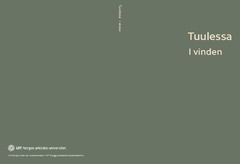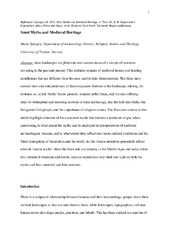Munin: Recent submissions
Now showing items 6581-6600 of 37055
-
Tuulessa - I vinden
(Book; Bok, 2023)Ønsket om å formidle forskning av kvensk kulturarv på en ny måte har resultert i vandreutstillinga Tuulessa – I vinden. -
Sámi Myths and Medieval Heritage
(Chapter; Bokkapittel, 2020)Sámi landscapes are pluralistic and contain traces of a variety of activities occurring in the past and present. This includes remains of medieval houses and hunting installations that are different from the ones used in later Sámi contexts. The Sámi have created their own interpretations of these enigmatic features in the landscape, relating, for instance, so-called ‘Stállo’ house grounds, reindeer ... -
Introduction: Currents of Saami pasts
(Chapter; Bokkapittel, 2020)A scientific field is a constant process, and, as all processes, it is defined by dialectics, since standpoints are only defined in opposition to something else. Saami archaeology is no exception, and this field emerged precisely because of oppositions, when political conflicts enforced the realization of a lack of consideration of the Saami presence in the prevailing understanding of the past in ... -
Sticky structures and opportunistic builders - The construction and social role of longhouses in northern Norway
(Chapter; Bokkapittel, 2020)The longhouse has been a turning point for research on prehistoric farming societies in Scandinavia for several decades. Yet, no comprehensive study has been made of this house type and its context, variations and social implications in the Far North. In this chapter, we present the currently available longhouse material within the three northernmost counties of Norway. The 50 longhouses that have ... -
On Spanish Dvandva and its restrictions
(Chapter; Bokkapittel, 2020)As noted by Bauer, real dvandva compounds –that is, coordinative compounds that properly express the aggregation of two different entities, not the intersection of properties in one entity– are extremely rare in English or Spanish. This article explores the empirical domain of dvandva compounding in Spanish, and notes that they are productive when not used as heads within their phrases. We propose ... -
Ways of being a dative across Romance varieties
(Chapter; Bokkapittel, 2020)In this article, we argue that the term dative can correspond to objects of a very different linguistic nature, even in typologically close languages. Specifically, in syntactic terms datives can be different from accusatives or identical to them at some point in the derivation; in the latter case, clashes between 3rd person clitics emerge. Our approach, then, argues that clitic incompatibilities ... -
Datives and stativity in psych predicates
(Chapter; Bokkapittel, 2020) -
Initiators, states and passives in Spanish psych verbs
(Chapter; Bokkapittel, 2020-12-08)The goal here is twofold: the first one is to point out the existence of at least two classes of Object Experiencer psychological verbs (henceforth, OEPV) in Spanish with respect to their passive behavior, casting doubt on Landau (2010), who proposes that passivization of OEPVs correlates with the availability of pseudo-passives in a language. The second one is to argue that passives of OEPVs match ... -
A Protocol for Single-Molecule Translation Imaging in Xenopus Retinal Ganglion Cells
(Chapter; Bokkapittel, 2020-04-29)Single-molecule translation imaging (SMTI) is a straightforward technique for the direct quantification of local protein synthesis. The protein of interest is fused to a fast-folding and fast-bleaching fluorescent protein, allowing one to monitor the appearance of individual fluorescence events after photobleaching of pre-existing proteins in the cell under investigation. The translation of individual ... -
Syntactic categorization of roots
(Chapter; Bokkapittel, 2020-02-28)A root is a fundamental minimal unit in words. Some languages do not allow their roots to appear on their own, as in the Semitic languages where roots consist of consonant clusters that become stems or words by virtue of vowel insertion. Other languages appear to allow roots to surface without any additional morphology, as in English car. Roots are typically distinguished from affixes in that affixes ... -
No Fair-Weather Instrument: The Need to Rethink Military Confidence Building in Europe
(Research report; Forskningsrapport, 2020)The current crisis of confidence in Europe has clearly had an impact on defence and security relations between Russia and the West. Against this backdrop, the relatively constructive and well-functioning working relations that currently hold among arms control units clearly stand out, calling for a critical rethinking of how confidence- and security-building measures (CSBMs) contribute to increasing ... -
Language Acquisition, Microcues, Parameters, and Syntactic Change
(Chapter; Bokkapittel, 2020)Based on both historical and present-day examples, this chapter discusses the connection between language acquisition and language change, focusing on generative approaches such as the cue-based theory of acquisition and change and grammar competition models. A number of problems are pointed out, mainly related to the generally target-consistent nature of first language acquisition and children’s ... -
Bridging the Gap: Experiments in the Heart of the Transition Zone
(Chapter; Bokkapittel, 2020)This book is about the on-going transition of fisheries governance and the emergence of research practices and advice frameworks that allow for the co-creation of common knowledge bases for management. This chapter introduces the context under which the GAP project (‘Bridging the gap between science and stakeholders') was conceived, describes its overall approach, orientates the reader to key issues ... -
Knowledge for Fisheries Governance: Participation, Integration and Institutional Reform
(Chapter; Bokkapittel, 2020)As outlined in Chapter 1, the GAP project is situated within a transition zone from a traditional fisheries management approach that relies upon a clear separation of knowledge towards a new ‘bridging perspective’, which aims to establish a common knowledge base for fisheries governance. The transition builds on collaborative practices of participatory research and joint knowledge production, as ... -
Bridging Gaps, Reforming Fisheries
(Chapter; Bokkapittel, 2020)Scientific debates often revolve around the issues of ‘unbiased science’ with the majority of scientists keeping themselves at arm’s length from policy-making to ensure their credibility. Participatory research has been shifting these dynamics and has led to the emergence of research practices and advice frameworks that allow co-creation of common knowledge bases for management. This chapter, following ... -
Conclusion
(Chapter; Bokkapittel, 2020)This chapter summarizes the arguments and discusses the results of the GAP project in the context of the ongoing reform in fisheries governance. -
Light in the Polar Night
(Chapter; Bokkapittel, 2020)How much light isa vailable for biological processes during Polar Night? This question appears simple enough. But the reality is that conventional light sen- sors for measuring visible light (~350 to ~700 nm) have not been sensitive enough to answer it. Beyond this technical challenge, “light” is a general term that must be qualified in terms of “light climate” before it has meaning for biological ... -
Small-Scale Fisheries Governance in Norway: Hierarchy, Institutions and Markets
(Chapter; Bokkapittel, 2020-04-29)Small-scale fisheries are highly relevant in Norway. Until 1989, small-scale fisheries were open access and, like other Norwegian fisheries, subsidised; since then they have changed radically. The closure of major fisheries in the early 1990s, following collapses in important stocks and the removal of direct subsidies, has affected fisheries of all sizes. Societal changes have also had an impact on ... -
Love across borders. Construction of gender equality and Norwegianness in Russian-Norwegian families.
(Chapter; Bokkapittel, 2020)More than 12 percent of the Norwegian population has immigration background, and immigrants play important parts in changing the Norwegian society from a seemingly homogenous to an evidently heterogeneous society. The Norwegian diversity policy was developed to encounter the challenges this represents. The goal of the policy is to create a society taking into account the individual’s right to be ... -
Johan Rist: Knife, sheath, náhppi, and guottahat (with knife, scissor and nállogoahti)
(Others; Andre, 2018)A glass case by the entrance at the Faculty of Humanities and Social Science-building contains objects that captivates the eye and creates a desire to touch. Hard materials, like wood, has taken on the texture of smooth velvet – and rough materials, like branched horns, materialize as sleek and gleaming through the exquisite artistry of Johan Rist.


 English
English norsk
norsk


















